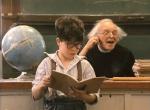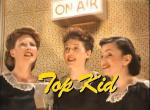AustLit
Latest Issues
AbstractHistoryArchive Description
Set in 1947, this short story explores the actions and consequences that arise from a young boy's moral dilemma. Ten-year-old Gary Doyle is the third child of a large, poor Catholic family. Bright and with a photographic memory, Gary is constantly picked on and beaten up by the boys at school. His teachers want him to go to a special school for bright kids where his talents will be better developed, but his father can't be convinced to let this happen. When Gary wins a radio quiz show and is asked to become a regular, he finds fame and fortune within his reach. But when they start rigging the show, the religious and ethical Gary has a difficult decision to make, as he becomes trapped between his belief in honesty and the benefits that fame can bring.
Source: Australian Screen.
According to Patricia Edgar's memoirs:
I was really upset when I went to view the director's cut of Top Kid, which was my favourite script in the series. [...] Bob Ellis had written an ending that was ambiguous but which explored the enormous pressures on the boy. I had submitted the script to Father Gerry Briglia at the Catholic Education Office for his advice on such a story for young people. He endorsed it strongly and reinforced my confidence that we should be doing provocative productions of this kind.
But Carl Schultz and Jane Scott didn't like the ending and had shot an alternative, unscripted version in which Gary stood up and said, 'I will not tell a lie'. I was horrified; the film had lost its point and been turned into the kind of moralistic, sermonising story for children I detested. I felt very sure of Ellis' likely response. The shoot was well over, so we had to work with the footage we had. But as the director had not believed in the film as written, when it was assembled the scripted ending did not work. There was a prolonged stand-off between me and Jane Scott. I insisted we invite Ellis to view the ending--without the moral line (and without telling him of the producer's attempt to create an alternative ending to his story)--and ask his advice. Bob came up with a very simple but clever solution to extend the line of dialogue from the boy over a freeze-frame and throw the question of judgement back to the audience to ask them what they would have done.
Source: Bloodbath: A Memoir of Australian Television, Melbourne: Melbourne UP, 2006, pp.167-68.
Notes
-
Telemovie.
-
The trailer for this episode is available to view via YouTube: http://www.youtube.com/watch?v=Eqeqld0SqFQ (Sighted: 28/9/2012)





